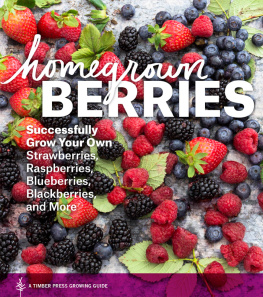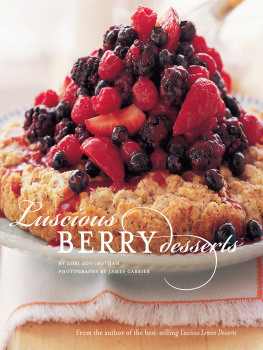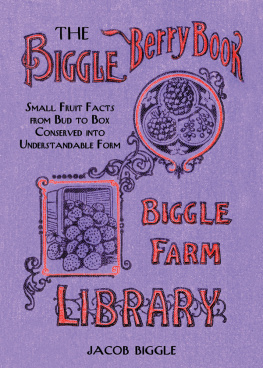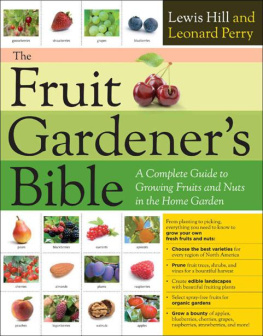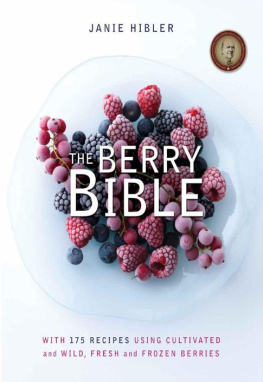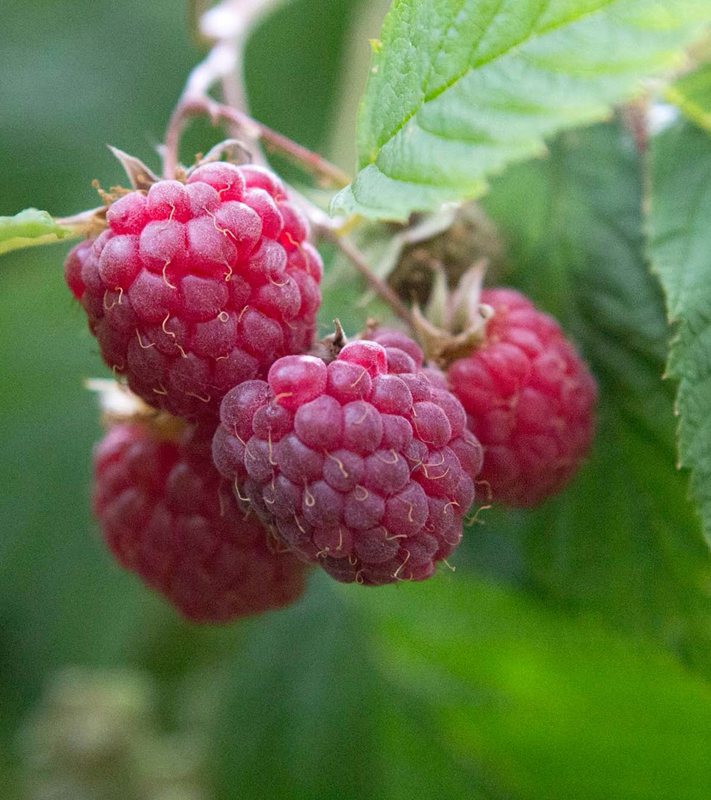
homegrown BERRIES
Successfully Grow Your Own Strawberries, Raspberries, Blueberries, Blackberries, and More
TIMBER PRESS
PORTLAND LONDON
Revised and expanded by Teri Dunn Chace.
New and revised material copyright 2014 by Timber Press, Inc. All rights reserved.
This work incorporates portions of The Berry Growers Companion
copyright 2000 by Barbara L. Bowling.
Frontispiece by Marci LeBrun
Illustrations by Kate Francis
Lettering by Patrick Barber
Published in 2014 by Timber Press, Inc.
The Haseltine Building 133 S.W. Second Avenue, Suite 450 Portland, Oregon 97204-3527 timberpress.com | 6a Lonsdale Road London NW6 6RD timberpress.co.uk |
Cover design by Breanna Goodrow
Text design by Patrick Barber
Library of Congress Cataloging-in-Publication Data
Homegrown berries: successfully grow your own strawberries, raspberries, blueberries, blackberries, and more.First edition.
pages cm
Other title: Successfully grow your own strawberries, raspberries, blueberries, blackberries, and more
Includes index.
This work incorporates portions of The Berry Growers Companion copyright 2000 by Barbara L. Bowling.
ISBN 978-1-60469-673-8
1. Berries. 2. Ornamental berries. I. Bowling, Barbara L. The berry grower's companion. II. Title. III.
Title: Successfully grow your own strawberries, raspberries, blueberries, blackberries, and more.
SB381.D86 2014
634'.7dc23
2014009483
contents
INTRODUCTION: YOU CAN DO IT!
Whether you are new to gardening berries, or new to gardening altogether, this book will help you welcome tasty, healthful, beautiful berries to the world that lies just beyond your doorstep. Just one homegrown berry, plucked on the way from drive to doorbell, can bestow a dizzying flavor profile, from sweet to tart to simply divine, and the ways to incorporate berries into the landscape can be similarly satisfying and diverse. Perhaps itll be as subtle as a delicate edging of strawberries along the path leading up to your front stoop. Or maybe itll be a bigger story, like a row of plump blueberry bushes or a property-defining fence, covered in trailing blackberries.
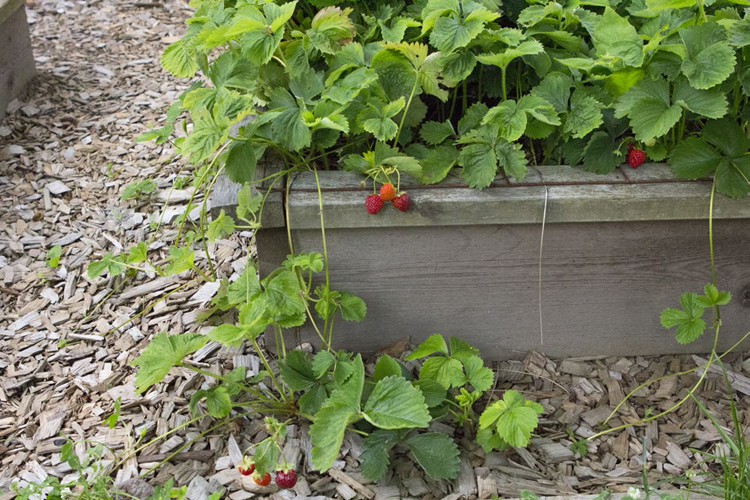
Raising berry crops on a small scale not only yields a tasty harvest, it makes an attractive scene. If you dont have a lot of space, choose more compact-growing cultivars and plant fewer plants.
What is a berry exactly? To botanists, a berry is a fruit that is multiseeded and derived from a single ovary. So, before we embark on this berry-growing journey, a confession: some of the fruits in this book (blueberries, currants, gooseberries, elderberries) are true berries; others (strawberries, raspberries, blackberries, Juneberries) are not. But for the purposes of this book, the common term berries will be employed for all. More important than terms, of course, are the joy, satisfaction, and delicious harvests your plantings will provide for seasons to come.
The basic concept of growing berries is hardly revolutionarythis diverse group of fruits has been a source of sustenance throughout historybut the ornamental value of berries in the landscape is increasingly recognized and celebrated. Its entirely doable to have a good-looking display that also feeds you and your family. Growth habits of berry plants range from groundcovers (strawberries) to vines that require support (trailing blackberries) to upright, freestanding shrubs (highbush blueberries). Any of these can become a significant part of your home landscape, as productive as a good vegetable garden or small home orchard and, with savvy siting and good care, no less attractive. If your yard space is at a premium, a collection of containers is a viable planting option for most of the berries in this book. And the ever-growing abundance of available cultivars means gardeners dont have to choose between the delicious, beautiful, and disease-resistant attributes of a plant. We can have it allan edible, natural-looking landscape that requires minimal maintenance once established.
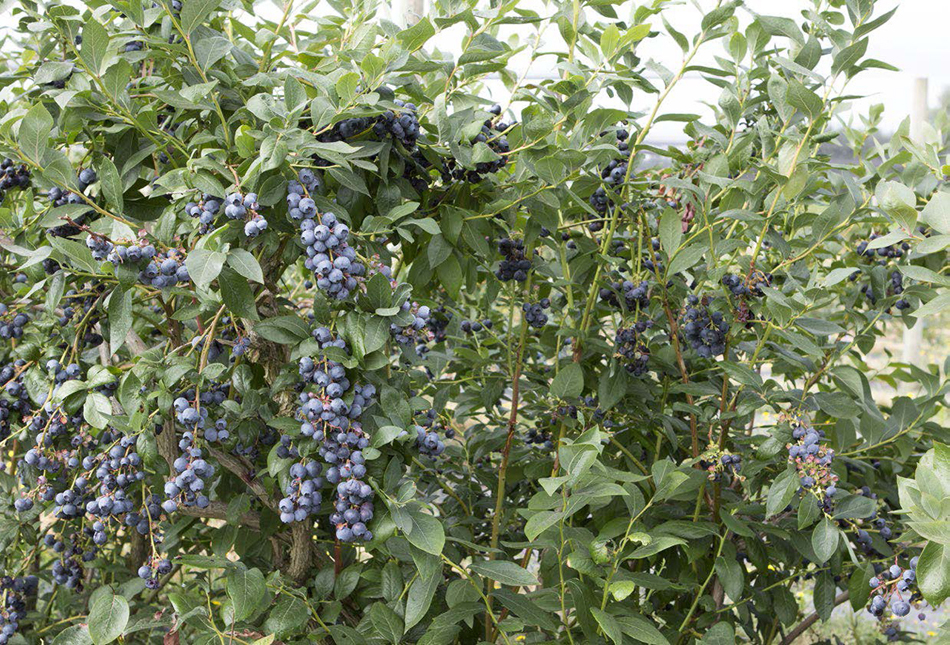
Ripe blueberries are easy and fun to pick. Your main competition will be from birdswhich can be kept away by netting until its time to harvest.
So, how to decide which berries are a good fit for you? Berry by berry, the chapters in this book will walk you through the best selections for home cultivation. You may choose to grow exotic-sounding elderberries or black currants simply because they are impossible to find at your local grocery store. Or perhaps youll be drawn to the basics that fill your berry fantasies all winter long: ruby-red strawberries, juicy blackberries, succulent blueberries. But keep in mind that even if they look visually familiar, your homegrown berries will almost certainly taste far superior to their mass-produced relatives. Because many berries are picked very firm, before they are ripe, to survive shipping and extend their short shelf life, those found on grocery shelves are often a bland, expensive disappointment. Fresh berries grown in your backyard, by contrast, will inspire commentOh my, this raspberry tastes like a raspberry. No fancy descriptors needed.
WHEN DO YOU WANT THEM?
Berries ripen from spring to fall. Some are ready in early summer, some color and sweeten up later in the season; a few go all summer long, once established. Also, within any one type, different cultivars ripen at different times, allowing you either to tailor the timing of the harvest to your climate and preferences, or to grow a few different cultivars in order to extend your picking season.
Ripening-season information (ranging from very early to mid to very late) will be listed with each recommended cultivar in the lists in the individual chapters. Make sure to study these lists with care, and crosscheck with local experts and your nursery source if you need help deciding. Heres the general picture, however:
Spring to midsummer: June-bearing strawberries, black raspberries, Juneberries, gooseberries, red currants, white currants.
Midsummer: red raspberries, purple raspberries, most blueberries, black currants, jostaberries.
Late summer into fall: fall-bearing red raspberries, fall-bearing blackberries, some blueberries (including rabbiteyes), elderberries, huckleberries, chokeberries, cranberries, lingonberries.
All summer (or on-and-off all summer): alpine strawberries, day-neutral strawberries.
Early summer and again in late summer or fall: everbearing strawberries, blackberries.
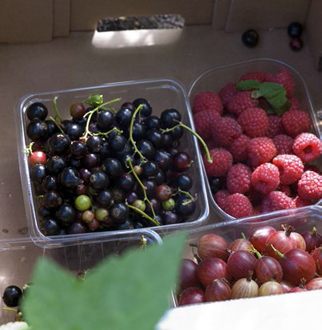
A three-season bounty of homegrown berries can be yours. Plant ones youve always wanted, but save a spot or two for ones you are less familiar withyou might be pleasantly surprised.
This remarkable assortment of shapes, sizes, and flavors is also astoundingly good for you. Berries are high in nutrition and fiber, low in fat, and often contain impressive levels of numerous healthful compounds. To complement these natural health benefits, the methods described in this book will give you all the tools youll need to grow your own berries without resorting to pesticides and other garden chemicals, which home gardeners increasinglyand naturallywant to avoid.
Next page
